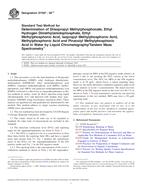Potřebujeme váš souhlas k využití jednotlivých dat, aby se vám mimo jiné mohly ukazovat informace týkající se vašich zájmů. Souhlas udělíte kliknutím na tlačítko „OK“.
ASTM D7597-09e2
Standard Test Method for Determination of Diisopropyl Methylphosphonate, Ethyl Hydrogen Dimethylamidophosphate, Ethyl Methylphosphonic Acid, Isopropyl Methylphosphonic Acid, Methylphosphonic Acid and Pinacolyl Methylphosphonic Acid in Water by Liquid Chro (Includes all amendments And changes 6/3/2016).
Automaticky přeložený název:
Standardní zkušební metoda pro stanovení diisopropylesteru methylfosfonátu, ethyl-vodíkové Dimethylamidophosphate, ethyl kyseliny Methylphosphonic, isopropyl kyseliny Methylphosphonic, kyselina Methylphosphonic a Pinacolyl kyseliny Methylphosphonic ve vodě Liquid chro
NORMA vydána dne 1.12.2009
Informace o normě:
Označení normy: ASTM D7597-09e2
Poznámka: NEPLATNÁ
Datum vydání normy: 1.12.2009
Kód zboží: NS-38796
Počet stran: 12
Přibližná hmotnost: 36 g (0.08 liber)
Země: Americká technická norma
Kategorie: Technické normy ASTM
Kategorie - podobné normy:
Anotace textu normy ASTM D7597-09e2 :
Keywords:
liquid chromatography, mass spectrometry, organophosphonates, ICS Number Code 13.060.50 (Examination of water for chemical substances)
Doplňující informace
| Significance and Use | ||||||||||||||||
|
Organophosphate pesticides affect the nervous system by disrupting the enzyme that regulates acetylcholine, a neurotransmitter. They were developed during the early 19th century, but their effects on insects, which are similar to their effects on humans, were discovered in 1932. Some are poisonous and were used as chemical weapon agents. Organophosphate pesticides are usually not persistent in the environment. , This test method is for the analysis of selected organophosphorous-based chemical weapon agent degradation products from Sarin (GB), Soman (GD), Tabun (GA) and VX. This method has been investigated for use with reagent and surface water. |
||||||||||||||||
| 1. Scope | ||||||||||||||||
|
1.1 This procedure covers the determination of diisopropyl methylphosphonate (DIMP), ethyl hydrogen dimethylamidophosphate (EHDMAP), ethyl methylphosphonic acid (EMPA), isopropyl methylphosphonic acid (IMPA), methylphosphonic acid (MPA) and pinacolyl methylphosphonic acid (PMPA) (referred to collectively as organophosphonates in this test method) in surface water by direct injection using liquid chromatography (LC) and detected with tandem mass spectrometry (MS/MS) using electrospray ionization (ESI). These analytes are qualitatively and quantitatively determined by this method. This method adheres to single reaction monitoring (SRM) mass spectrometry. 1.2 This test method has been developed in support of the National Homeland Security Research Center, US EPA by Region 5 Chicago Regional Laboratory. 1.3 The values stated in SI units are to be regarded as standard. No other units of measurement are included in this standard. 1.4 The detection verification level (DVL) and reporting range for the organophosphonates are listed in Table 1. 1.4.1 The DVL is required to be at a concentration at least three times below the reporting limit (RL) and have a signal/noise ratio greater than 3:1. Fig. 1 displays the signal/noise ratios at the DVLs for the organophosphonates in the ESI positive mode and Fig. 2 in the ESI negative mode. 1.4.2 The reporting limit is the concentration of the Level 1 calibration standard as shown in Table 2 for the organophosphonates except for MPA in the ESI negative mode which is at Level 2 due to not meeting the DVL criteria at the lower concentration level. The DVL for MPA in the ESI negative mode is at 20 μg/L, which forces a raised reporting limit. However, the multi-laboratory validation required a spike of all target analytes at Level 1 concentrations. The mean recovery for MPA in the ESI negative mode at this level was 98.7 % as shown in Table 3. If your instrument’s sensitivity can meet the requirements in this test method, MPA may have a 50 μg/L reporting limit. 1.5 This standard does not purport to address all of the safety concerns, if any, associated with its use. It is the responsibility of the user of this standard to establish appropriate safety and health practices and determine the applicability of regulatory limitations prior to use. |
||||||||||||||||
| 2. Referenced Documents | ||||||||||||||||
|
Doporučujeme:
Aktualizace technických norem
Chcete mít jistotu, že používáte pouze platné technické normy?
Nabízíme Vám řešení, které Vám zajistí měsíční přehled o aktuálnosti norem, které používáte.
Chcete vědět více informací? Podívejte se na tuto stránku.




 Cookies
Cookies
